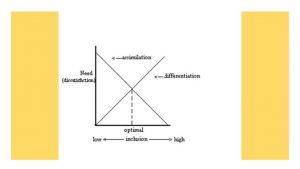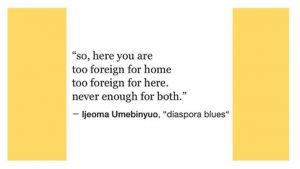 Autoethnography—Am I Confirming and Assimilating?
Autoethnography—Am I Confirming and Assimilating?
By Anita Nahal, Ph.D., CDP
Diversity Consultant, ESVB-AAUW
This article is an adaptation of the author’s original article on LinkedIn
In March 2005, I gave a lecture at Howard University as part of a series on Multiculturalism in the Classroom. My particular lecture was on, “A South Asian teaching African American/Indian (comparative) courses at an Historically Black College and University (HBCU),” wherein towards the end of the video you will see that I wore a shawl and bindi and spoke about what might be the effect of my visual appearance if I went to the class like that and spoke about African American Women’s History to a class of predominantly African American students, while dressed like an Indian (I could not change into a saree, however, attempted to replicate an ethnic look). Only the last minute or two of the video are relevant to what I am saying. Please click her for the video: http://www.cetla.howard.edu/new_showcase/lectures/speakers/nahal/index.html
I constantly face my own assumptions on where I stand in the American fabric. Recently, it struck me even more deeply while discussing with a friend about cultural expressions. We both erstwhile South Asians now Americans, talked about how we both don’t wear traditional clothes except on ethnic occasions such as festivals, weddings or funerals. The discussion took me to Dr. Marilynn B. Brewer’s Optimal Distinctiveness Theory and made me question as to where we stood in her various definitions? Were we part of “inclusion” wherein we were treated as insiders while allowed and encouraged to retain our uniqueness? Were we part of “differentiation” wherein we were not considered as insiders but allowed and encouraged to retain our uniqueness. Or were we part of “assimilation” wherein we were treated as insiders only when we confirmed to the cultural norms of the majority. Or finally as per Dr. Brewer’s matrix, were we part of “exclusion or dissatisfaction” wherein we were neither treated as insiders nor our uniqueness valued. (Please see Brewer’s chart below)
Upon pondering, one considers that certain critically labeling words are attached to the above four markers in the matrix such as, “treated” “allowed” “encouraged to retain” and “majority.” Why do immigrant groups have to be treated as such or such, or allowed and not allowed, or encouraged to retain? Why would immigrants not decide for themselves how much they wished to retain and how they wished to portray themselves, or how much they were willing to allow others to make them feel belonged or not? Of course, these are rhetorical questions as a number of research studies have been conducted on the notions of belonging and/or alterity for immigrants. In one study, I found some of the below questions very pertinent to the questioning of my own continuous assumptions about myself:
“… (1) During life, when does belonging to a nation, ethnic group or a culture become important for an individual? (2) How does self-definition impact how one deals with specific experiences, such as being a refugee? (3) What are the impacts of the process of migration on one’s sense of belonging? (4) How do immigrants re-construct their sense of belonging in their host societies? (5) How is the sense of belonging to a collective expressed in different generations in families of immigrants? (6) What is the impact of being a citizen of a country versus being a temporary resident on one’s sense of collective belonging? And (7) How do intergenerational conflicts manifest themselves in terms of identity ownership? (For further on this work, please see, Ethnicity and Belonging: An Overview of a Study of Cuban, Haitian and Guatemalan Immigrants to Florida by Julia Chaitin, J.P. Linstroth & Patrick T. Hiller in, http://www.qualitative-research.net/index.php/fqs/article/view/1363/2856 )”
The opposing need of individuals according to Dr. Brewer has led them into a tug of war between their desires to feel “belonged” yet retaining their “uniqueness.” And yes, I have felt these tugs sometimes living in the West, in relation to me or others. When I wear traditional clothes, the way folks look at me, some admiringly, some wondering, some ignoring and some disdainfully. Some of the same reactions I too have shown towards others in ethnic clothes, and especially towards those from India. Visual representation feeds deeply into our comfort level and since we don’t know the other person as it is, the ethnic clothes become an additional layer of being unknown and thus to be feared. This in turn can lead to any number of biased ways—implicit and unconscious– we might be perceived or perceive others. “The implicit associations we harbor in our subconscious cause us to have feelings and attitudes about other people based on characteristics such as race, ethnicity, age, and appearance.” (Kirwan Institute for the Study of Race and Ethnicity, Ohio State University. http://kirwaninstitute.osu.edu/wp-content/uploads/2014/03/2014-implicit-bias.pdf).
Unconscious bias in particular, of which we all are culprit, can in turn lead to challenges in cultural competency, and in diversity and inclusion in professional spaces in all HR practices from recruiting, hiring to promotion to terminations.
Interestingly the tugs of assimilation/conformity I feel pulling at me in reverse when I go to India for a visit as well. I don’t wear skirts and dresses that come up only till my knees… or shorts, or other too skin revealing clothes. Perhaps no one will say anything (as some of my younger friends strongly argue that times have changed), yet I feel, due to my early upbringing in India, that folks in their fifties and beyond are supposed to dress in a particular way in public. Regardless of what my younger friends say, I still feel the “looks” from strangers, friends or relatives if my clothes are too revealing or not age suitable. My “otherness or alterity” is very apparent to me in India as much as it is in the US. Where do I belong, sometimes I question? Do I belong anywhere I choose and am comfortable? Or do I belong a little here and little there, or nowhere? I am reminded of Nigerian poet, Ijeoma Umebinyuo’s poignant poem:
All this is something to think about especially in relation to Dr. Brewer’s four classifications, in relation to unconscious bias, cultural competency and diversity and inclusion. I am still debating whether I am confirming and assimilating to the American fabric, and do the same while on a visit to India. And I have touched upon only visual identification in my auto-ethonographical analysis. There are so many other ways to confirm and assimilate; speech, tone, gestures, body language; marriage, job, education, religion and so forth. In a new study done by neuroscientists (Ryan M. Stolier and Jonathan B, Freeman) at New York University, on the way individuals react to diverse faces, they have shown that, “The stereotypes we hold can influence our brain’s visual system, prompting us to see others’ faces in ways that conform to these stereotypes.” ( http://www.nyu.edu/about/news-publications/news/2016/05/02/neuroscientists-find-evidence-for-visual-stereotyping.html and http://www.nature.com/articles/nn.4296.epdf )
A variation of this article appeared on LinkedIn first. The author’s other posts on LinkedIn can be found at: https://www.linkedin.com/today/author/0_3f28uu9Qt9H17RnSMhdqZW?trk=prof-sm


